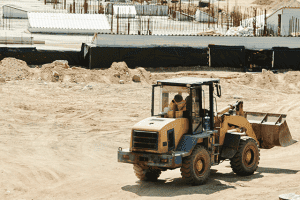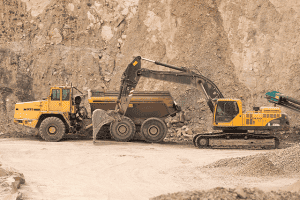Introduction to Construction Site Safety Technology
In Australia, construction is a significant part of the economy, with a plethora of large-scale infrastructure and building projects. With the abundance of activity, ensuring the safety of workers, especially pedestrian workers who are on foot and not operating machinery, is paramount. The pedestrian workers are often involved in tasks that require navigating through cluttered spaces with heavy machinery, which makes them highly susceptible to accidents. Pedestrian workers are often the most vulnerable on construction sites. Without the protection of being inside a vehicle or operating
With issues such as pooor visibillity and difficult to enforce boundaries, The BodyGuard pedestrian safety warning system‘s advanced technology, with its ability to detect pedestrian workers through solid objects, addresses a pressing need in the Australian construction industry. With the country’s commitment to workplace safety and stringent regulatory frameworks, adopting such innovative solutions aligns with Australia’s objectives to create safer working environments.
Construction sites are notorious for being hazardous environments. The continual movement of heavy machinery, presence of construction materials, and often-complex nature of the sites themselves contribute to a high-risk atmosphere. Visibility is a critical factor in ensuring the safety of workers, but it is often compromised due to cluttered spaces, solid barriers, or adverse weather conditions. Addressing this issue, an innovative technology has been developed that can detect construction workers wearing special tags through most solid objects, adding an indispensable layer of safety.
Tags and Sensors
Central to this safety system are the tags and sensors. Construction workers wear tags that are integrated into their safety vests or helmets. These tags are equipped with radio-frequency identification (RFID) or similar technologies, allowing them to communicate with sensors installed around the construction site. What sets this technology apart is the capability of these sensors to detect signals from the tags even when workers are behind walls, equipment, or other solid barriers.

Communication and Data Processing
The sensors are connected to a central processing unit that continually monitors the signals from the tags. The system analyzes the data to ascertain if any worker is in proximity to potential hazards, especially in areas where visibility is compromised. Whenever a pedestrian worker wearing a tag is detected too close to the vehicle both the vehicle operator and pedestrian get a clear warning.
Worker Safety Warning System
The primary application of this technology is as a safety warning system for construction workers. The system is activated when a worker wearing a tag is in close proximity to potential hazards, particularly in areas with poor visibility or where line of sight is obstructed. This is crucial in preventing accidents caused by machinery moving in congested spaces.
Upon detecting a potentially hazardous situation, the system can trigger various alerts. Auditory alarms can be sounded; lights can be flashed; both the vehicle operator’s system and the worker’s wearable device or tag. These alerts serve as an immediate call to action, allowing the involved parties to take necessary measures to prevent an accident.
In addition to real-time detection and alerts, the system has an optional feature that can employ data analytics to predict possible collisions or unsafe movements. By understanding the typical flow of activity on the site and analyzing movements of machinery, the system can provide early warnings and action recommendations to mitigate risks before they materialize.
Cutting-Edge Detection for Pedestrian Workers: Beyond the Line of Sight
Imagine a bustling construction site with the cacophony of machinery, towering cranes, and swarms of workers donned in high-visibility clothing. While such scenes are typical, construction sites can often present challenging environmental conditions such as dust clouds, torrential rain, or fog, which significantly hinder visibility. In such scenarios, ensuring the safety of pedestrian workers – those on foot navigating through the site – becomes a top priority. What if there was a system that could peer through the haze, as if possessing superhuman sight, safeguarding those who are most vulnerable?
Enter an advanced detection system that’s revolutionizing pedestrian worker safety. Unlike traditional safety systems which rely heavily on line of sight, this innovation works flawlessly even in the dustiest, wettest, and most visually impairing conditions. How does it manage this feat? Through a combination of cutting-edge sensors and smart technology. These sensors are not swayed by environmental factors; they continuously scan the surroundings for signals from tags worn by pedestrian workers, ensuring their presence is accounted for irrespective of visual barriers or poor weather.
The real kicker is in how this impacts safety procedures. With the ability to ‘see’ pedestrian workers through poor visibility, the system enables rapid response times. Site managers can be alerted instantaneously if a pedestrian worker is in a hazardous area, allowing for immediate action. Moreover, machinery operators can receive notifications, ensuring they’re aware of the pedestrian workers’ presence nearby, thus avoiding any mishaps.
This technology is not just an incremental upgrade; it’s a monumental leap forward. In a domain where fractions of seconds can be the difference between safety and calamity, ensuring that pedestrian workers are detectable in all conditions is invaluable. Construction sites in Australia and beyond should seriously consider adopting this breakthrough technology, not only to protect the lives of pedestrian workers but also to foster a culture of safety that permeates through every layer of the construction industry.
Advantages for Construction Sites
1. Enhanced Safety: By detecting workers through solid objects, the technology ensures a higher level of safety, significantly reducing accidents due to poor visibility or obstructed lines of sight.
2. Increased Efficiency: Improved situational awareness allows for more efficient planning and execution of construction activities, minimizing unexpected disruptions due to safety hazards.
3. Liability Reduction: The adoption of an advanced safety system showcases a construction company’s commitment to worker safety, which may contribute to reduced liability in the event of accidents.
4. Data Collection and Analysis: The system allows for the collection of valuable data which can be analyzed for insights into improving workflows and further enhancing safety measures.
5. Does not rely on line of sight: The system can detect pedestrian workers on the construction site in dusty, wet and other poor visibility conditions.
Conclusion
The introduction of safety systems capable of detecting construction workers through solid objects represents a significant advancement in construction site safety. This technology offers a plethora of benefits, including enhanced safety, increased efficiency, and the ability to proactively address potential hazards. Nevertheless, it is crucial to ensure ethical use and to protect the privacy and dignity of construction workers. The construction industry, regulatory bodies, and technology providers need.
